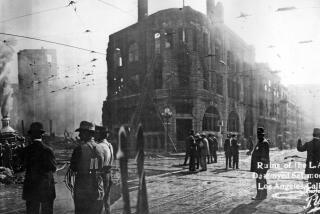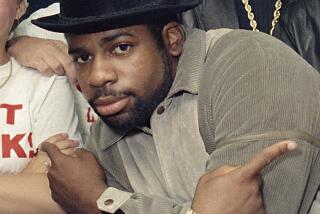McVeigh Targeted Federal Building, Witness Testifies
- Share via
DENVER — One of the key witnesses in the government’s case against Timothy J. McVeigh testified Tuesday afternoon that the former Army soldier chose the Oklahoma City federal building for destruction because he believed--wrongly--that it was the home office of agents who two years earlier had raided a religious compound near Waco, Texas.
Lori Fortier, whose husband is already serving prison time for unrelated charges in the bombing, also said that McVeigh considered the Alfred P. Murrah Federal Building an “easy target” for a terrorist attack.
“He said it was a U-shaped building and it had a glass front,” she said. “He said it was an easy target and that it was a building that houses some of the people that were in the Waco raid.”
Fortier’s testimony marked the first time that McVeigh has been directly linked--in public--to the Murrah building bombing.
She said that four months before the bombing, McVeigh and her husband visited Oklahoma City while transporting stolen weapons from Kansas to her desert home in Kingman, Ariz.
“Tim mentioned that they had gone through Oklahoma City,” she said. “He drove by Oklahoma City and he showed Michael the building.”
The nine-story structure, in the heart of Oklahoma City, indeed had a top-to-bottom glass front, which came crashing down in the blast, which the government says was from a two-ton truck bomb parked in front of the building. Killed in the April 19, 1995, explosion were 168 people, including 19 children in a day care center on the second-floor.
Fortier’s testimony outlined what she knew before the blast occurred and how she had first lied about what she knew. In 2 1/2 hours of testimony, only once did her voice break. That was at the very end of the day, when chief prosecutor Joseph Hartzler asked her repeatedly why she felt some responsibility for the bombing.
“I don’t know,” she said, looking down at her lap. “I wish I could have stopped it now. If I could do it all over again, I would have.”
Instead, Fortier said, she and her husband lied about their activities with McVeigh in the months before the bombing. And when they later admitted their involvement, it was only to save themselves from possible prosecution and the death penalty, she said.
Her testimony and that of her husband, who is expected to take the witness stand later in the trial, are the prosecution’s linchpins in what otherwise is a mostly circumstantial case against McVeigh.
So crucial is Fortier’s testimony that before she took the witness stand the government gave her a formal grant of immunity from prosecution. That was done in a brief, Tuesday morning hearing before another federal judge here.
When Fortier later stepped into the witness box, she did so calmly. Dressed in an attractive black suit, she seemed well-prepared and spoke in a clear, confident voice.
Across the courtroom sat McVeigh. He leaned back in his chair, cupping a knee with each hand, and stared coldly at Fortier throughout much of the afternoon. The action appeared to unnerve her.
But in her testimony, Fortier broadly implicated not only McVeigh in the bombing but Terry L. Nichols, a McVeigh Army buddy, who is to stand trial after he does. Each could receive the death penalty if convicted.
On the day in August 1995 when McVeigh and Nichols were indicted, Michael Fortier pleaded guilty to charges of having known beforehand about the bombing, not telling authorities and illegally transporting stolen weapons.
Lori Fortier testified that McVeigh and Nichols rented storage lockers, purchased ammonium nitrate and waited patiently for the two-year anniversary of the fiery April 19, 1993, raid near Waco that killed about 80 people inside the Branch Davidian religious compound.
She said that McVeigh was incensed about Waco, that he grew long hair and a “scruffy” beard and posed briefly as a biker--all while he went about preparing for the bombing. So detailed were his plans, she said, that McVeigh devised an escape route that would take him into the desert mountains around Las Vegas.
Fortier also acknowledged that she was using illegal drugs such as speed and marijuana “weekly” in 1995, as well as having lied to authorities after the bombing about McVeigh’s statements and activities. She said that she and her husband were afraid of McVeigh and feared that they would be implicated as conspirators in the bombing. At one point, she said, her husband carried a gun when he met with McVeigh.
“I didn’t want to be linked to Tim in any way,” she said.
But within hours of the bombing, Fortier testified, she and her husband decided to lie because of the quick and decisive reaction of Washington officials.
“I saw [Atty. Gen] Janet Reno get up and say she wanted the death penalty,” Fortier said. “And I was scared for my family. So I didn’t say anything. I felt responsible that he [McVeigh] had told us about it and I didn’t do anything.”
Later, when Fortier learned that the bomb had been set off inside a truck rented by someone named Robert Kling, she recalled that she had helped McVeigh create a phony driver’s license using that name.
“I put it together in my head,” she said.
She pulled the ribbon out of her typewriter that she had used to make the license, and then burned the tape in an ashtray in her kitchen, she said--all in a desperate attempt to shield her involvement in what became the worst terrorist attack in American history.
“I was scared we would be linked to Tim,” she explained.
Lori Fortier met McVeigh through her husband, when both men, along with Nichols, served in the Army at Ft. Riley, Kan., in the late 1980s, she said. Over the years, McVeigh often lived with the Fortiers in Kingman and he served as best man at their wedding.
By 1993, she said, McVeigh had become enraged at the government, particularly over the FBI raid near Waco. By the fall of 1994, she said, he was determined to strike back.
“He thought the government had murdered people at Waco,” she said. “He thought the United Nations’ plan was to take over America.”
In letters and visits, she said, McVeigh warned the Fortiers that it was time to “take action” against the government. Asked what he meant, she said, he told them: “to blow up a building, a federal building.”
Fortier said that McVeigh drew a picture of how he planned to build a bomb inside a truck, drawing circles to depict the barrels of ammonium nitrate inside the cargo bin. Later, she said, he used a dozen soup cans to illustrate how the bomb would be built.
She quoted McVeigh as saying that he and Nichols stole blasting caps from a Kansas quarry. And she said that he told her and her husband that Nichols had robbed a friend of McVeigh’s named “Bob”--who the government says actually is a gun collector named Roger Moore in Royal, Ark.
“He said Terry had robbed Bob and he was upset that Terry did not kill Bob,” she testified.
According to the government, proceeds from the sale of the weapons, coins and other possessions taken in the robbery were used to further the bombing conspiracy. But Fortier said that in the months before the blast, many of McVeigh’s friends began to try to back out of his plans.
“Nobody wanted to help him and he was upset,” she said. “He was upset because Terry wanted out. Terry did not want to mix the bomb. So he asked Michael to help him.”
What did her husband say? Hartzler asked Fortier.
“No,” she said.
And did her husband agree to help McVeigh in his escape plan?
“No,” she said.
Fortier is to return to the witness stand this morning.
(BEGIN TEXT OF INFOBOX / INFOGRAPHIC)
THE NEXT STEP
Lead defense attorney Stephen Jones will conduct a critical cross-examination of Lori Fortier today. The defense hopes to discredit her and her husband, Michael Fortier, who will testify later. Attorneys may concentrate on Lori Fortier’s admission that she lied to the FBI, friends and relatives in the weeks after the bombing. “I didn’t want [authorities] to implicate us. I was scared,” she said.
More to Read
Sign up for Essential California
The most important California stories and recommendations in your inbox every morning.
You may occasionally receive promotional content from the Los Angeles Times.











